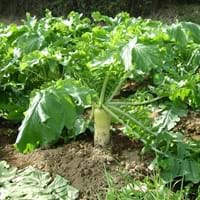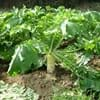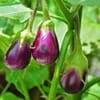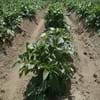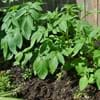Life Span
Annual or Biennial
Annual
Origin
Europe, Asia
Europe, Asia
Types
April Cross, Cherry Belle, Sicily Giant
Admiral Pepper,Bell Pepper,Mohawk Pepper,Yolo Wonder Pepper
Number of Varieties
Not Available
Habitat
Unknown
Cropland, Oil fields, Waste areas
USDA Hardiness Zone
Not Available
4-9
AHS Heat Zone
8-1
Not Available
Sunset Zone
A1, A2, A3, H1, H2, 1a, 1b, 2a, 2b, 3a, 3b, 4, 5, 6, 7, 8, 9, 10, 11, 12, 13, 14, 15, 16, 17, 18, 19, 20, 21, 22, 23, 24
Not Available
Habit
Rosette/Stemless
Clump-Forming
Flower Color Modifier
Bicolor
Not Available
Fruit Color
Not Available
Green, Tan
Leaf Color in Spring
Green
Green
Leaf Color in Summer
Green
Not Available
Leaf Color in Fall
Green
Green
Leaf Color in Winter
Not Available
Green
Leaf Shape
Spinach Type
Egg-shaped
Plant Season
Spring, Summer, Fall
Not Available
Sunlight
Full Sun
Full Sun, Partial Sun
Growth Rate
Very Fast
Very Fast
Type of Soil
Loam
Clay, Loam, Sand
The pH of Soil
Neutral
Acidic, Neutral, Alkaline
Soil Drainage
Well drained
Well drained
Bloom Time
Indeterminate
Early Spring, Spring, Late Spring, Late Fall, Early Winter, Winter, Late Winter
Tolerances
Drought
Pollution
Where to Plant?
Ground
Ground, Pot
How to Plant?
From bulbs
Stem Planting, Transplanting
Plant Maintenance
Medium
Medium
Watering Requirements
Keep the ground moist but not water-logged
Prefer drip-irrigation instead of Over-head watering, Water Deeply
In Summer
Lots of watering
Lots of watering
In Spring
Moderate
Moderate
In Winter
Average Water
Average Water
Soil pH
Neutral
Acidic, Neutral, Alkaline
Soil Type
Loam
Clay, Loam, Sand
Soil Drainage Capacity
Well drained
Well drained
Sun Exposure
Full Sun
Full Sun, Partial Sun
Pruning
No pruning needed
Prune ocassionally, Prune to control growth
Fertilizers
All-Purpose Liquid Fertilizer, Compost, Fertilize the soil instead of direct applying
All-Purpose Liquid Fertilizer
Pests and Diseases
Alternaria leaf blight, Black root rot, Clubroot, Damping-off, Downy mildew, Fusarium wilt, Scab, white rust
Not Available
Plant Tolerance
Drought
Drought
Flowers
Insignificant
Insignificant
Flower Petal Number
Single
Single
Fragrant Bark/Stem
Yes
No
Foliage Texture
Coarse
Fine
Foliage Sheen
Matte
Not Available
Attracts
Butterflies
Not Available
Allergy
Headache, Itchiness, Skin rash, Stomach pain
Not Available
Aesthetic Uses
Not Used For Aesthetic Purpose
Not Used For Aesthetic Purpose
Beauty Benefits
Not Available
Not Available
Environmental Uses
Not Available
Air purification
Medicinal Uses
Asthma, Bronchitis, Cancer, Cardiovascular problems, constipation, Dehydration, Diabetes, Fever, High blood pressure, Immunity, Insect Bites, Jaundice, Kidney problems, Leucoderma, Liver problems, Piles, Respiratory Disorders, Skin Disorders, Sore throat, Urinary tract problems, Vitamin C, Weight loss
Not Available
Part of Plant Used
Leaves, Root
Not Available
Other Uses
Employed in herbal medicine, Used As Food
Unknown
Used As Indoor Plant
No
No
Used As Outdoor Plant
Yes
Yes
Garden Design
Edible, Herb, Vegetable
Not Available
Botanical Name
RHAPHANUS sativus
CARDAMINE hirsuta
Common Name
Radish plant
Hairy Bittercress
In Hindi
मूली
बालों वाली Bittercress
In German
Rettich Pflanze
Hairy Bittercress
In French
usine de radis
Bittercress Poilu
In Spanish
planta de rábano
Bittercress Peludo
In Greek
φυτικά ραπανάκι
τριχωτές Bittercress
In Portuguese
planta radish
Bittercress cabeludo
In Polish
rzodkiewka roślin
włochaty Bittercress
In Latin
raphanus herba
pilosus bittercress
Phylum
Magnoliophyta
Magnoliophyta
Class
Magnoliopsida
Magnoliopsida
Order
Capparales
Brassicales
Family
Brassicaceae
Brassicaceae
Clade
Angiosperms, Eudicots, Rosids
Not Available
Tribe
Not Available
Not Available
Subfamily
Not Available
Not Available
Number of Species
Not Available
Not Available
Importance of Radish Plant and Hairy Bittercress
Want to have the most appropriate plant for your garden? You might want to know the importance of Radish Plant and Hairy Bittercress. Basically, these two plants vary in many aspects. Compare Radish Plant and Hairy Bittercress as they differ in many characteristics such as their life, care, benefits, facts, etc. Every gardener must at least have the slightest clue about the plants he wants to plant in his garden. Compare their benefits, which differ in many ways like facts and uses. The medicinal use of Radish Plant is Asthma, Bronchitis, Cancer, Cardiovascular problems, constipation, Dehydration, Diabetes, Fever, High blood pressure, Immunity, Insect Bites, Jaundice, Kidney problems, Leucoderma, Liver problems, Piles, Respiratory Disorders, Skin Disorders, Sore throat, Urinary tract problems, Vitamin C and Weight loss whereas of Hairy Bittercress is Not Available. Radish Plant has beauty benefits as follows: Not Available while Hairy Bittercress has beauty benefits as follows: Not Available.
Compare Facts of Radish Plant vs Hairy Bittercress
How to choose the best garden plant for your garden depending upon its facts? Here garden plant comparison will help you to solve this query. Compare the facts of Radish Plant vs Hairy Bittercress and know which one to choose. As garden plants have benefits and other uses, allergy is also a major drawback of plants for some people. Allergic reactions of Radish Plant are Headache, Itchiness, Skin rash and Stomach pain whereas of Hairy Bittercress have Not Available respectively. Having a fruit bearing plant in your garden can be a plus point of your garden. Radish Plant has no showy fruits and Hairy Bittercress has no showy fruits. Also Radish Plant is not flowering and Hairy Bittercress is not flowering . You can compare Radish Plant and Hairy Bittercress facts and facts of other plants too.
